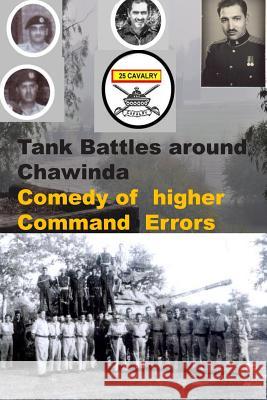Tank Battles around Chawinda-Comedy of higher Command Errors » książka
Tank Battles around Chawinda-Comedy of higher Command Errors
ISBN-13: 9781494798574 / Angielski / Miękka / 2013 / 174 str.
Harbaksh Singh's findings prove otherwise and even Gurcharan Singh does not glorify Indian tanks so much as to have reached 'within few yards' from the Pakistani defences Shaukat's account is good as a motivational speech for other ranks or for school children or may be a good citation for getting gallantry awards but definitely not good military history Another development on 13th September was the capture of Pagowal (Bhagowal) by the 69 Mountain Brigade assisted by a tank squadron. The last major development of this period was the arrival of the 4th Armoured Brigade comprising one tank regiment, one motorised infantry battalion and one self propelled artillery regiment (5 Horse,1 FF and 15 SP ) from Khem Karan adding yet another fresh tank regiment to assist 6 Armoured Division. This brigade had been pulled out from Khem Karan on 11/2 September and reached Sambrial a little west of Sialkot by train on the night of 12/13 September 1965. It was commanded by Brigadier Riaz ul Karim an MC from Burma who had taken over from Brigadier Lumbs on 11th September 1965 and was also deputy GOC 6 Armoured Division.78 Indian attack on Chawinda-14th & 15th September: -- By early morning 14th September the 6 Armoured Division was deployed as following: -- (1) Guides Cavalry, 22 Cavalry and 14 FF organised under a headquarter known as Combat Command-Colonel Wajahat from Gunna Kalan west of Pagowal till Jassoran in the south a frontage of 12,000 yards (2) 24 Brigade comprising three infantry battalions, one R & S Company and one tank regiment (2 Punjab,3 FF, 14 Baluch, B Company 13 FF and the indomitable 25 Cavalry) was holding the pivot of the whole battle i.e. Chawinda area (3) 14 Para Brigade with three and a quarter infantry battalions, one R & S Company and a tank squadron holding Pasrur and Zafarwal. The Indians who thought in steps and at the tactical level now decided to capture Chwainda. Salient features of the Indian plan to capture Chawinda, which was to be put into execution at first light 14th September were as following: -- (1)Horse to advance from Chahr to Fatehpur and cut road Badiana-Pasrur in area Buttar and then swing Southeast towards Sarangpur with a view to destroying Pakistani armour which may try to escape from or attempt to reinforce Chawinda . (2)17 Poona Horse to thrust toward Kalewali-Chawinda and be prepared to support 43 Lorried Infantry Brigade's assault on Kaliwal-Wazirwali and later Chawinda if ordered (3) 69 Mountain Brigade Group (including 16 Cavalry) to ensure that Pakistani armour was prevented from joining the main armour battle in area south of Phillora and Chawinda from direction of Sialkot . (4)43 Lorried Brigade with under command one infantry battalion from 35 Infantry Brigade to advance and attack Chawinda from firm base at Phillora. (5)1 Artillery Brigade to concentrate in area Saboke in support of 1 Armoured Division . As it was obvious the Indian assault being frontal did not make much progress and by last light 14th September the Indians made nominal progress capturing the villages of Kalewali, Wazirwali and Alhar. The area captured was so limited that the tactical pre condition of an infantry assault was not satisfied due to limited space for manoeuvre and the planned infantry attack on Chawinda was not launched. Harbaksh Singh who unlike Shaukat Riza and some other Pakistani historians does not distort history to prove that the Indians were
Zawartość książki może nie spełniać oczekiwań – reklamacje nie obejmują treści, która mogła nie być redakcyjnie ani merytorycznie opracowana.











